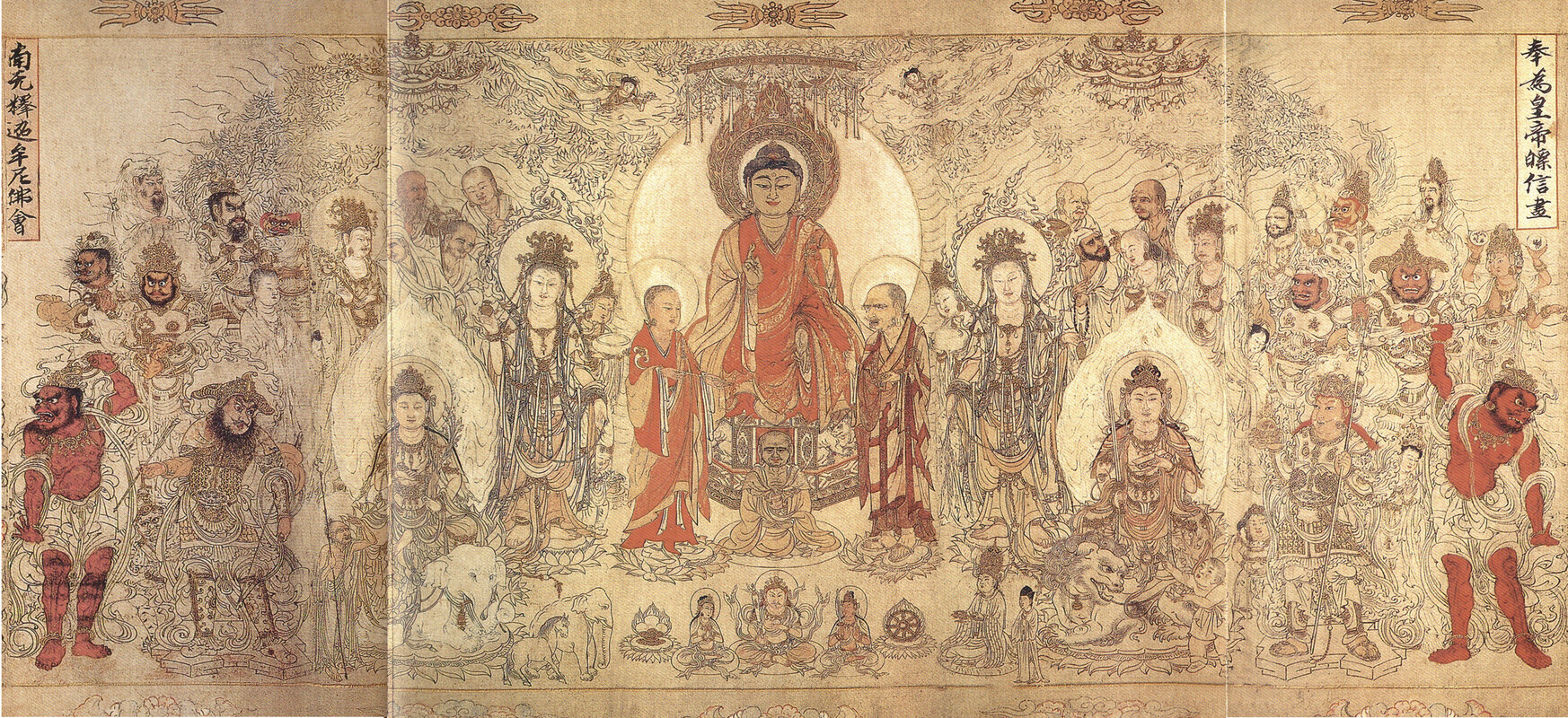 |
||
| The main figures in the group are Śākyamuni Buddha and the Bodhisattvas, Mañjuśrī and Samantabhadra. The Buddha is the largest figure in the group, as is to be expected. Of the same size as Mañjuśrī and Samantabhadra, are Avalokiteśvara and Mahāsthāmaprāpta, the two Guardian Kings (Vaiśravaṇa and Virūḍhaka) and the two red Vajrapani. Kassapa and Ananda area little smaller; and most of the other members of the group are about the same size, but are only partially visible. Vasu Ṛṣi, Śrī Mahādevī, and the children are still smaller. The whole group is held together by the two Vajrapani and by the background of the trees in foliage and the rays of light which form a kind of halo for the whole assemblage. Above Mañjuśrī and Samantabhadra are large two-tiered canopies surmounted by a wheel, with ju-i shaped clouds beneath ; these, together with the canopy over the central figure of Śākyamuni, indicate the trinity and help to unite the group. |
||
| 67 | 65-66 | 63-64 |
Samantabhadra is seated on his elephant, which is reclining and rests on a lotus. Samantabhadra holds in his right hand a five-pointed vajra and in his left, a spray of flowers. Standing to his right, is a Brahmān with a long staff, probably Vasu Ṛṣi. Behind Samantabhadra are four monks and Brahmā, the latter holding a fan. In back of Brahmā, is a child. The four monks, together with Kassapa, Ananda and the four monks behind Mañjuśrī, constitute the Ten Great Disciples. They are: |
Śākyamuni Buddha sits in the center of a large group on a lion throne, his hands in dharmacakra mudrā, dressed in red and yellow robes. Behind him is a huge, plain white halo; and within this outer halo is an elaborate inner halo, shaped like a leaf of the Bodhi tree, encircling the head of the Blessed One. Above is a circular canopy with hanging garlands, to each side of which is a flying Apsaras, carrying flowers. Rays of light radiate in all directions from the Buddha. The whole group is in the shade of four trees, the leaves of which are seen above the topmost heads. To the extreme right of the leaves is seen a phoenix, and to the extreme left a dragon. The Buddha is immediately attended by Kassapa (left) and Ananda (right), both standing. In accordance with tradition, Kassapa is represented as an old man and Ananda, as a young one. Seated in meditation in front of the throne is a monk whose body is gold in color, dressed in a yellow outer robe and pink under robe, with a dull gold scarf over his shoulders. His hands are in dhyana mudrā. In the foreground are the seven gems of the Cakravartin: from right to left, 1.the wheel; 2. the general with a sword (or perhaps the minister?); 3. the minister with a mace in his right hand and a jewel in his left (or perhaps the general?); 4. the woman; 5. the cintāmani (jewel); 6. the elephant; and 7. the horse. To the right of the wheel, is an important person, probably a king or prince of Yunnan, kneeling with an incense burner in his hands. An attendant, in a black hat, stands nearby, his hands in añjali mudrā, Ananda is dressed in a red and yellow robe and holds in both hands a ju-i; Kassapa, in purple and yellow, holds an indeterminable object in his left hand and makes the dharmacakra mudrā with his right. Behind Kassapa is a Bodhisattva (or Deva?) with a large bowl, and between the two, is a child. Associated with Ananda in the same way, are two similar figures. |
Mañjuśrī is seated on his lion, which is in a recumbent position and rests on a lotus. He holds the Prajñāpāramitāsūtra in his left hand and the Sword of Truth (with which he cleaves the clouds of ignorance) in his right. His face, even under its repainting, shows Central Asian influence... for example, in his almond eyes and pointed ears. A fat child to the right of Mañjuśrī holds a lotus in his left hand, at which the lion seems to be looking. |


